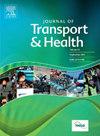Exploring preferences for interventions to increase active school transportation among children and adolescents in Australia
IF 3.3
3区 工程技术
Q2 PUBLIC, ENVIRONMENTAL & OCCUPATIONAL HEALTH
引用次数: 0
Abstract
Introduction
The observed decline in children's active school transport (AST) across numerous countries over recent decades necessitates targeted, multi-level interventions to reverse this trend. However, data on young people's preferred AST interventions is lacking. This study aimed to explore children's preferences for AST interventions and assess differences between AST users and non-users among primary and secondary school students.
Methods
In 2023, a cross-sectional survey was conducted in Perth, Western Australia with n = 742 primary school students from 23 schools and n = 412 secondary school students from 9 schools. The survey assessed AST frequency, preferred transport mode, and AST intervention preferences, which included ‘built environment changes’ (n = 7), ‘policy changes’ (n = 3), ‘public transport’ (n = 2), ‘school-based programs and services’ (n = 6) and ‘community awareness’ (n = 3) initiatives.
Results
For primary school students, the most common mode of transport was by car. However, the most preferred method was walking. For secondary school students, the most common and the most preferred method was by car. Regardless of age or AST use, the majority of students' most preferred interventions were ‘built environment changes’. These included: ‘more safe crossings near the school’, ‘paths on both sides of every road within the school catchment area’, and ‘dedicated bike paths separated from the roads’.
Conclusions
This study provides valuable insights into the interventions students self-report as most effective for increasing their AST. The findings indicate a strong preference for built environment modifications among the top interventions selected by students, suggesting built environment changes should be a priority in developing future AST interventions.
探索干预措施的偏好,以增加活跃的学校交通在澳大利亚的儿童和青少年
近几十年来,许多国家观察到儿童主动上学交通(AST)的下降,因此有必要采取有针对性的多层次干预措施来扭转这一趋势。然而,缺乏关于年轻人首选AST干预措施的数据。本研究旨在探讨儿童对AST干预的偏好,并评估中小学生中AST使用者和非使用者之间的差异。方法于2023年在西澳大利亚州珀斯市进行横断面调查,共有来自23所学校的n = 742名小学生和来自9所学校的n = 412名中学生。调查评估了AST频率、首选交通方式和AST干预偏好,其中包括“建筑环境变化”(n = 7)、“政策变化”(n = 3)、“公共交通”(n = 2)、“基于学校的计划和服务”(n = 6)和“社区意识”(n = 3)举措。结果小学生出行最常见的交通方式为汽车。然而,最受欢迎的方法是步行。对于中学生来说,最常见和最受欢迎的方法是开车。无论年龄或AST使用情况如何,大多数学生最喜欢的干预措施是“建筑环境改变”。其中包括:“学校附近有更多安全的十字路口”,“学校集水区内每条路的两边都有小路”,以及“与道路分开的专用自行车道”。本研究为学生自我报告的最有效提高AST的干预措施提供了有价值的见解。研究结果表明,在学生选择的顶级干预措施中,建筑环境的改变是强烈的偏好,这表明在未来的AST干预措施中,建筑环境的改变应该是优先考虑的。
本文章由计算机程序翻译,如有差异,请以英文原文为准。
求助全文
约1分钟内获得全文
求助全文

 求助内容:
求助内容: 应助结果提醒方式:
应助结果提醒方式:


